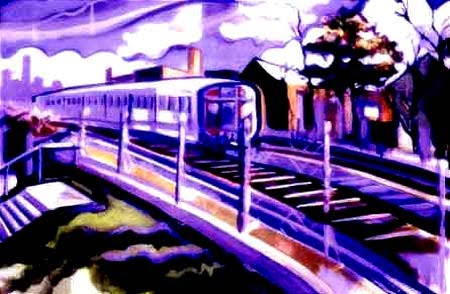 |
| Sacramento Regional Transit's light-rail and bus networks share cross-platform connections at the city's Sacramento Valley rail station. |
The simple truth is effective passenger rail systems cannot realize their full potential without strong, complimentary networks of bus transit routes. There is not a single rail transit operation (heavy rail metro/subway, light rail, commuter rail, streetcar) that doesn't offer convenient connections to local bus routes. I know the importance of this first-hand as a daily rider of both bus and rail here in the Washington, D.C., region. Bus routes help satisfy many of the first mile / last mile needs of passengers and are crucial mainline transit carriers on corridors without quite enough density to support rail transit. The majority of transit trips – each day, each month, each year – happen on a bus.
And yet, despite the fundamental role buses play in our nation's transportation network, investment for bus capital needs – namely to buy new buses and construct new garages and maintenance facilities – actually decreased during the most recent version of the nation's surface transportation legislation, known as MAP-21 this time around. Although the two-year bill boosted levels of investment in formularized programs for both bus and rail transit, it completely eliminated the dedicated source of funding for new buses and bus facilities. Rail transit operations found their investment streams held steady for both maintaining aging infrastructure and launching new projects.
Not only was this outcome profoundly unfair to the nation's bus systems and the millions of people who use them, but it undercuts the ability of passenger rail systems to best serve their passengers. Without new buses to replace well-traveled vehicles and new or upgraded facilities to keep them maintained, the reliability of connecting bus routes decreases, ultimately impacting rail ridership. Moreover, rail advocates find a more receptive audience for additional transit projects of any kind when elected officials and community leaders recognize the value of all transit options, including effective bus service in smaller urban and rural communities. Do not underestimate the importance of this perception when legislation to fund high-speed, intercity and local rail projects comes before Congress or state legislatures.
What can be done to resolve this disparity? In short, simply restore the bus capital program in whatever legislation ultimately succeeds MAP-21. The process of hearings and constituent input for its reauthorization is already underway on Capitol Hill.
The Small Urban Network of the Community Transportation Association of America (CTAA) – the organization which publishes RAIL Magazine – has identified four key priorities to help meet bus transit needs around the nation, most importantly the restoration of $890 million for bus capital needs that was the standard level of investment in the legislation that preceded MAP-21.
The trouble, though, is that most observers expect that Congress will not increase investment levels in the reauthorization process, given that the transportation trust fund that delivers investment for surface transportation programs is now bringing in lower levels of revenue than needed to support those programs. Efforts to raise new revue – such as increasing the federal gas tax or instituting new revenue methods, such as Vehicle Miles Traveled (VMT) – have no legitimate support by leaders in either party at the national level. Congress will have to scramble to move funds around just to keep investment at its current level.
As a result, cuts were necessary. In MAP-21, those cuts were borne, in large part, by the elimination of the bus capital program while the rail capital programs remained whole. The impact of that decision has been that many transit systems are running buses well past their recommended retirement age and construction of new bus facilities has ground to a halt.
Some public transportation advocates believe somehow more revenue will appear during the reauthorization process and the bus capital program will be restored without impacting current levels of investment, including rail programs. There is absolute consensus that such an outcome would be desirable for the entire industry. All advocates should make this case loudly and repeatedly.
However, the likelihood of new revenue materializing is minuscule in the current political environment. In such a world, many rail advocates seem like they would be okay with maintaining MAP-21's imbalance of investment between the bus and rail programs. Those same advocates also claim that changing that balance would amount to a modal fight and disrupt the chances of reauthorization legislation succeeding in Congress, essentially arguing that bus advocates should take what they're given and go home with their tail between their legs.
Bus advocates at this stage have nothing to lose by arguing against this imbalance, as their investment levels in MAP-21 were already decimated. It is highly unlikely that Congress would not simply extend the current structure of the legislation if a new agreement was not reached before MAP-21's October 1 expiration date. Were that the case, bus advocates would do no worse than they're already doing by receiving nothing. Rail wouldn't do any worse, either.
Accordingly, its in the interest of all sides to take measures to restore the bus capital program in whatever surface transportation legislation comes next. No one benefits when bus programs are pitted against rail operations, which MAP-21 succeeded in doing. The outcome is less effective transit networks for all passengers, whether they take bus or rail.





No comments:
Post a Comment